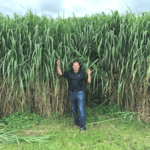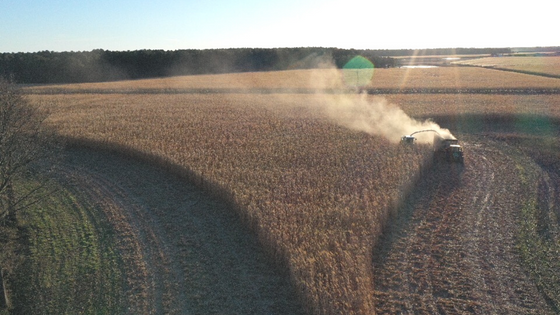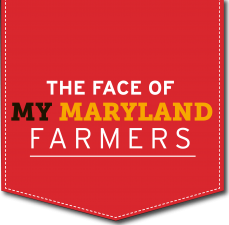 Mowing the lawn is a dreaded chore for many of us. But farmers John and Kim Luthy let the grass grow tall on their Dorchester County farm. The grass the Luthys grow is called Miscanthus. It’s a purpose-grown crop that grows to heights of around 12 feet and is being cultivated for use as poultry bedding.
Mowing the lawn is a dreaded chore for many of us. But farmers John and Kim Luthy let the grass grow tall on their Dorchester County farm. The grass the Luthys grow is called Miscanthus. It’s a purpose-grown crop that grows to heights of around 12 feet and is being cultivated for use as poultry bedding.
“The Miscanthus that we grow is Freedom® Giant Miscanthus, which is a perennial, warm-season hybrid grass,” says farmer John F. Luthy, IV. “I have a relationship with AGgrow Tech that allows me to obtain certified root stock for planting and production, ensuring genetic purity.” This means that the grass is sterile and non-invasive.
Like other grasses, Miscanthus grows quickly during the summer months, and goes dormant in the winter. This works out well for John, who is able to harvest the Giant Miscanthus from January through April, when other crops are not planted or growing. “This has allowed me an additional window of time to operate equipment and earn revenue,” he says. “The whole production system is a game-changer.”
Certainly the game plan has changed over the last century on this fourth-generation farm. “The Luthy Farms’ heritage traces back to the 1890s when my great-great grandfather Godfrey Luthy immigrated from Switzerland to Nebraska then to Maryland. That was the start of our family’s farming legacy that my great grandfather, grandfather, father, me and my son have continued to foster for the last 100-plus years,” John says.
Over this time, the farm’s acreage has expanded and farming production has, too. Traditionally, the farm grew corn, soybeans and wheat. In the earlier days, cattle roamed the land. More recently, Giant Miscanthus, Orchard and Fescue grasses have been added to corn and soybean production.
John began growing Giant Miscanthus for an Eastern Shore poultry integrator to use as poultry bedding to ensure the company’s supply. A poultry integrator is the owner of the processing plant, hatchery and the feed mill. The integrator pays others for services, such as a farmer to raise small chicks to market size, providing the poultry bedding and feed to the farmer.
According to John, this type of grass makes an ideal poultry bedding material that is absorbent and long lasting. Once installed in the poultry house, the material has proven to be three times more absorbent than traditional pine shavings, which means a healthier environment for birds.
Not only is it good for chickens, but this grass also provides environmental benefits. “Giant Miscanthus sequesters large amounts of carbon, provides for reduced soil erosion, and holds soil to prevent nutrient run-off,” John says. “My customers have recognized this added value, and I hope others, including federal and state agencies, continue to evaluate its production benefits so that conservation programs can be tailored to this perennial production.”
In addition, AgGrow Tech is exploring other uses for Miscanthus, such as liquid biofuels, combustion for electricity and heat, alternatives to single-use plastics and erosion control. So, now when you mow your grass, your perspective may be a little different.
Hungry for more? Learn more about ornamental and native grasses to beautify your yard. Read about how Miscanthus could mitigate climate change.
Sign up for our newsletter and find us on Facebook, Twitter and Instagram.

